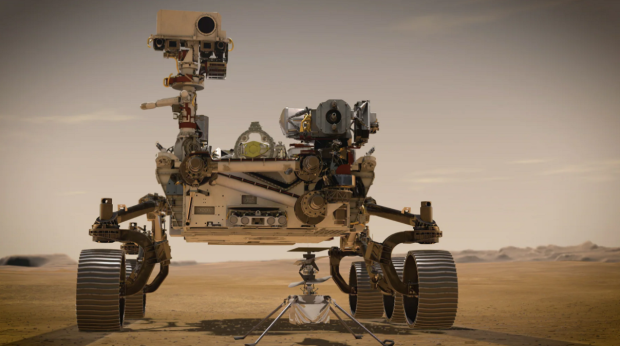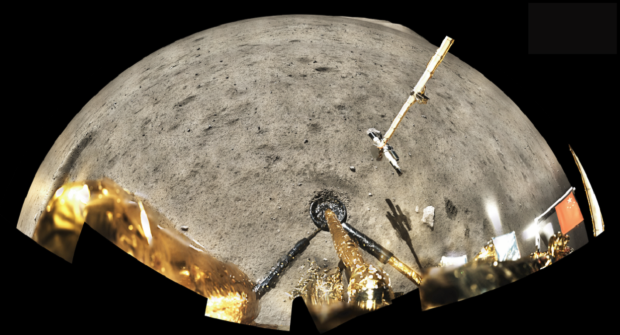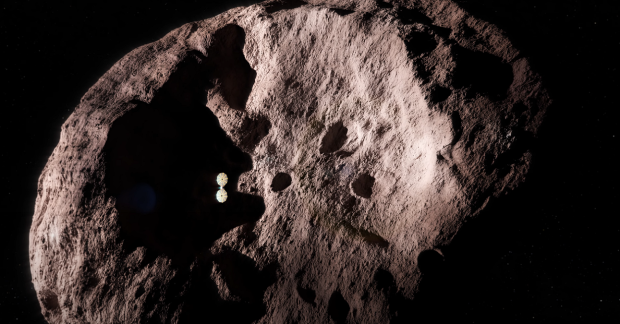Science, Space, Health & Robotics News - Page 263
ISS astronauts take image of a strange, 'very rare' glow above Europe
As you can probably imagine, astronauts aboard the International Space Station have an awesome view of the planet from their position, and sometimes they spot things that are strange.
Astronaut Thomas Pesquet recently spotted something of this nature and posted the image to Twitter, explaining the strange phenomenon that was seen over Europe. According to Pesquet, what was spotted was called a "transient luminous event" in the upper atmosphere, and according to the astronaut, it's a "very rare occurrence".
So what is it? Pesquet says that this phenomenon happens when there's lightning in the upper atmosphere that is occurring at higher altitudes than it normally does. Pesquet wrote on Flickr, "What is fascinating about this lightning is that just a few decades ago they had been observed anecdotally by pilots and scientists were not convinced they actually existed". Jokingly, Pesquet added, "Fast forward a few years and we can confirm elves, and sprites are very real and could be influencing our climate too!"
Continue reading: ISS astronauts take image of a strange, 'very rare' glow above Europe (full post)
Crazy image from space shows bulls-eye clouds above erupting Volcano
The volcano located on Spain's Canary Islands has been erupting for weeks, and a satellite has snapped an incredible photo of it from space.
The eruption of the volcano on La Palma started on September 19 and has continued for weeks now, marking the first time an eruption has happened out of this volcano in more than 50 years. On October 1, the Moderate Resolution Imaging Spectroradiometer (MODIS) that is equipped on NASA's Aqua satellite snapped a crazy image of the clouds above the volcano as it passed overhead. The image shows concentric cloud rings that look very much like a bulls-eye.
According to NASA's Earth Observatory, the concentric clouds that can be seen in the image are a result of a rising column of superheated ash and gases, which is described as an "eruption column". Additionally, NASA explains that "The buoyant column of water vapor and other gases rose rapidly upward until colliding with a drier, warmer layer of air at roughly 5.3 kilometers (3.3 miles) altitude. The unusually warm air above-a temperature inversion-functioned like a lid, preventing the volcanic plume from rising any higher. Instead, it flattened out and spread horizontally."
Continue reading: Crazy image from space shows bulls-eye clouds above erupting Volcano (full post)
NASA's human Mars colonists may live in these inflatable pods
NASA is already planning on what kind of structures human colonists will live in when they arrive on Mars, and inflatable pods may be a viable choice.
NASA selected a design from Hassell Studio, an architectural firm, and Eckersley O'Callaghan, an engineering design team, and it's unlike any other proposed design for living quarters on the Red Planet. The design concept was posted to the Hassell YouTube channel back in March 2019, and it details a concept that concentrates on protecting the astronauts that live in it from the main dangers of Mars; dust storms, high amounts of radiation, low temperatures, and an unlivable atmosphere.
The team at Hassell proposes sending several robots to the surface of Mars before the astronauts arrive. These robots will be programmed to find a viable location for an outer shell made out of Mars regolith, or loose rock, to be 3D printed. This outer shell, constructed with Mars soil, will protect the astronauts from the elements of Mars and will essentially be a roof over the inflatable pods that will arrive with the astronauts. Once the shell is complete, and the astronauts arrive, the inflation process for the pods begins.
Continue reading: NASA's human Mars colonists may live in these inflatable pods (full post)
NASA takes steps to finding ancient life on Mars with wild new images
Researchers have published a new study that confirms that the Jezero Crater was once home to large amounts of liquid water and a river.
The study was published in Science, and according to the researchers, the images taken by NASA's Perseverance of cliffs show strong evidence of layers within the cliffs that are similar to Earth's river deltas. According to the researchers, the images show a presence and a steady flow of water, which caused the formation of the cliff/crater floor. Additionally, researchers inferred that Mars was once "warm and humid enough to support a hydrologic cycle" around 3.7 billion years ago.
The findings from the Mars rover and the analysis provided by the researchers will assist NASA in guiding Perseverance to the location that has the highest chance of containing "bio-signatures" of ancient microbial life. NASA astrobiologist Amy Williams and her team, who found similarities between the cliff formation, crater floor, and Earth's river deltas, said, "From orbital images, we knew it had to be water that formed the delta. But having these images is like reading a bo/ok instead of just looking at the cover."
Continue reading: NASA takes steps to finding ancient life on Mars with wild new images (full post)
NASA's Perseverance Mars rover was spied on, image from above taken
NASA's Perseverance rover that's stationed on Mars in the Jezero Crater has been spotted from above by a passing satellite.
Perseverance landed in the Jezero Crater back in February earlier this year, and since its landing, it has been exploring the area that surrounds it along with its helicopter companion Ingenuity. Perseverance is on the Red Planet to collect samples of rock and dirt to eventually transport them back to Earth for researchers to analyze.
Ultimately, Perseverance has been sent to Mars to hunt for signs of ancient microbial life, and recently studies confirmed that the location where Perseverance is stationed was once a large lake and a river. NASA's Mars Reconnaissance Orbiter passed over Perseverance exploring the Jezero Crater and managed to snap a birds-eye-view of the rover, the image is located above. Communication between NASA, the rover, and its companion has temporarily been paused as Earth and Mars move to opposite sides of the Sun.
Continue reading: NASA's Perseverance Mars rover was spied on, image from above taken (full post)
Lunar samples analyzed, the results rewrite the history of the Moon
China's Chang'e 5 mission collected 3.8 pounds of lunar material from a region on the Moon that was once a large plain of molten lava.
The first paper detailing the results of the samples being analyzed has recently been published in Science, and according to the findings, the volcanic rock located in the landing site is much younger than what researchers first anticipated. According to the paper, lunar volcanoes were erupting as early as 2 billion years ago, which means that researchers' current model of the Moon's history now needs to be adjusted to fit in the new data.
Study co-author Brad Jolliff, a planetary scientist, and mineralogist at Washington University in St. Louis, said, "So we got the stuff less than a billion, and the stuff older than 3 billion, [but] there's this big gap of 2 billion years - from 1 to 3 billion years ago - that we had no actually calibrated surfaces. And so this result now gives us that age - and it's right in the middle!"
Continue reading: Lunar samples analyzed, the results rewrite the history of the Moon (full post)
NASA's rover confirms something big on Mars, potential 'signs of life'
With images acquired by NASA's Perseverance rover, the space agency has confirmed that the Jezero Crater was once a large lake.
NASA landed the Perseverance rover in the Jezero Crater back in February this year with the goal of developing a deeper understanding of Mars' history and identifying any potential signs of past life. Now, a new study published in the journal Science has confirmed through an analysis of images taken by Perseverance of outcropping rocks inside the crater that the crater was once a lake bed fed by a small river 3.7 billion years ago.
The researchers confirmed the existence of the lake and river by looking at the sedimentary layers in the outcrop and found that the river provided the lake with a steady flow of liquid water until a dramatic shift in climate caused mass flooding that was near the end of the lake's lifespan. Now that it has been confirmed that the Jezero Crater was once a lake, researchers hope to find traces of ancient aqueous life in the sediments. Perseverance will acquire sediment samples that will eventually be transported back to Earth to be scanned for Martian biosignatures.
Continue reading: NASA's rover confirms something big on Mars, potential 'signs of life' (full post)
NASA will collide a spacecraft into an asteroid at 15,000 mph
NASA has locked in a launch date for the Double Asteroid Redirection Test (DART), which is a mission that will collide a spacecraft with an asteroid at 15,000 mph.
The idea behind the DART mission is to see if it's possible to collide a spacecraft with an asteroid to knock it off course. The DART mission is a part of the agency's asteroid defense program and will be exploring the possibility of a potentially lethal asteroid lining its trajectory up with Earth. The asteroid that the DART spacecraft will be colliding with isn't lethal to Earth, but the results from the mission will allow NASA to know if direct impacts on an asteroid are a viable solution for diverting a dangerous asteroid in the future.
The asteroid that NASA is targeting is called Didymos, it's a binary asteroid which means its two space rocks moving in tandem. The larger asteroid measures 2,600 feet in diameter, and the smaller asteroid measures 525 feet in diameter. NASA is planning on colliding the spacecraft with the smaller of the two asteroids. NASA will launch the DART mission from the Vandenberg Air Force Base in California aboard SpaceX's Falcon 9 rocket.
Continue reading: NASA will collide a spacecraft into an asteroid at 15,000 mph (full post)
NASA will soon explore mysterious space 'fossils' that hold secrets
NASA will soon be launching the first mission to explore two swarms of space "fossils" that may hold the keys to understanding the evolution of our solar system.
NASA's Lucy mission will be the first mission to explore the Jupiter Trojans, which are two swarms of ancient asteroids orbiting on the same plane as Jupiter. NASA describes these asteroids as "fossils" of planet formation, and researchers believe that understanding these mysterious objects will allow them to better understand the evolution of the solar system.
Lucy will be on a 12-year mission, and will visit a total of seven different asteroids. NASA has equipped Lucy with sensitive scientific instruments that will allow the probe to inspect asteroids to find out its geology, age, surface temperature, and composition of the surface. Each of the target asteroids is different from each other as NASA wants to be able to compare the different surfaces properties.
Continue reading: NASA will soon explore mysterious space 'fossils' that hold secrets (full post)
Study finds nuking an asteroid could prevent a surprise apocalypse
A new study has explored the possibility of having limited time to react to an asteroid that is on course with Earth.
The researchers behind the study performed calculations on what Earth would need to do to save it from impact with an asteroid that's 328 feet in diameter, which is around a fifth the size of the famous asteroid Bennu. The study found that a 1-megaton-yield nuclear bomb would be a "very effective" way of preventing a catastrophic impact. Researchers performed the simulation on five different asteroids and multiple time frames for impact.
According to the researchers, if an asteroid 328 feet in diameter was heading to Earth and we had just two months before its expected arrival, a nuke would be able to reduce the destruction it would cause to 0.1% of what it originally would have caused. Additionally, if a larger asteroid was on its way and Earth had six months to react, a nuke would still be able to reduce its impact mass to just 1%.
Continue reading: Study finds nuking an asteroid could prevent a surprise apocalypse (full post)











